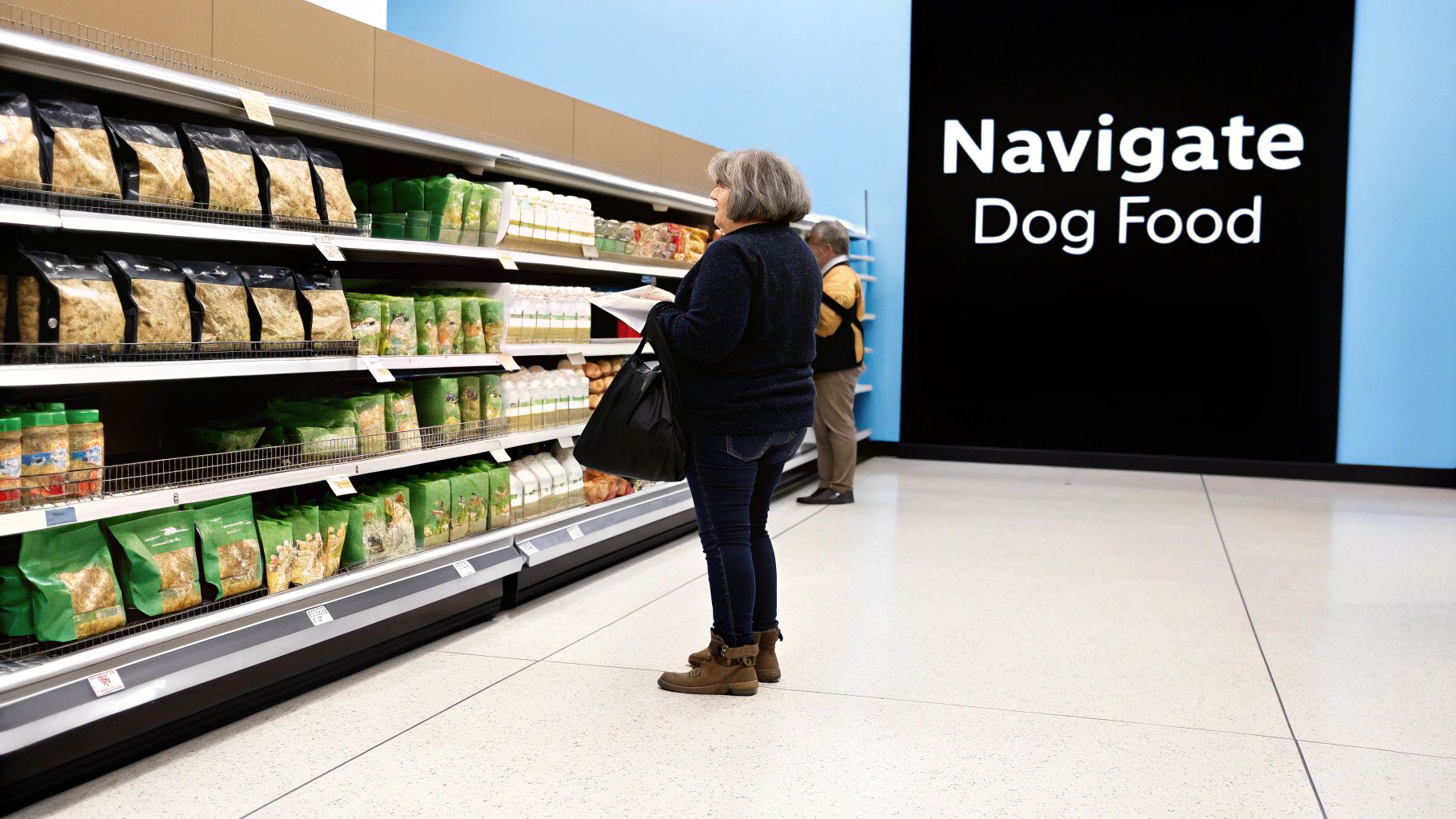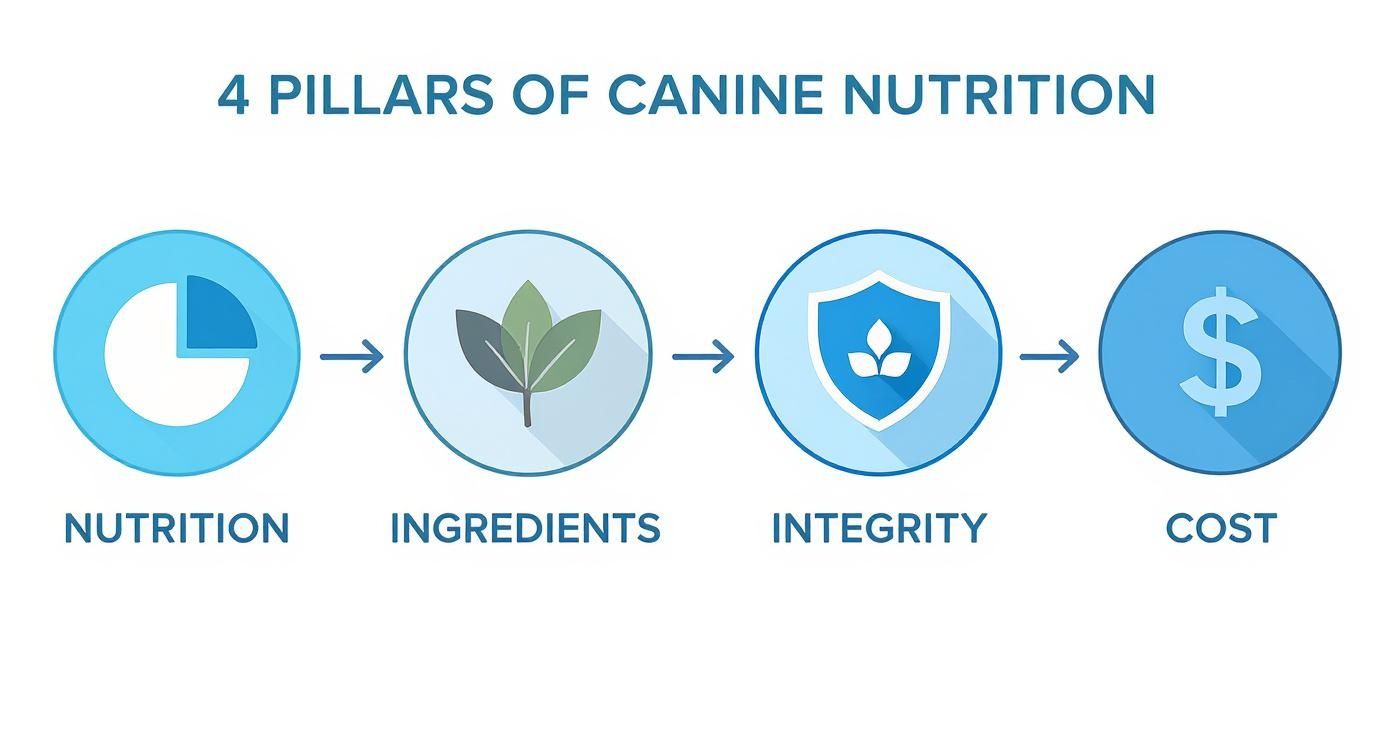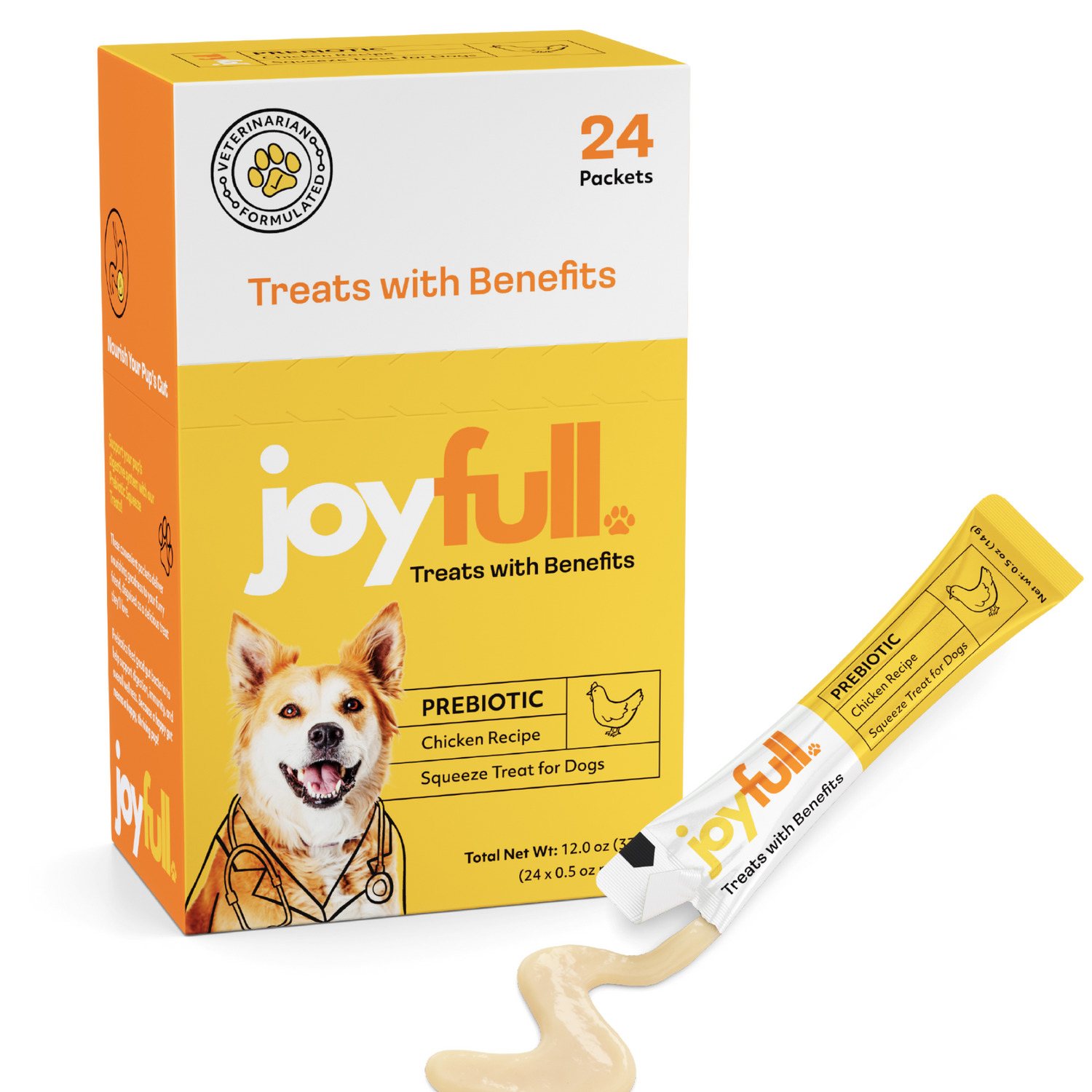
Dog Food Comparison Chart for Smart Pet Owners
Walking into the dog food aisle can be overwhelming. The shelves are a kaleidoscope of shiny bags, all shouting about "premium" ingredients and "natural" formulas. It's a tough decision, but a good dog food comparison chart can cut through that noise. It helps you focus on what truly matters: nutritional value, ingredient quality, and the real cost per meal—not just the clever marketing. This guide will give you that much-needed clarity.
How to Navigate the Dog Food Aisle

That dizzying array of choices isn't just in your head; it's the result of a massive, booming industry. The global pet food market is expected to rocket from US$132.4 billion in 2025 to an astounding US$247.7 billion by 2035. With dog food making up over 60% of that market, the competition is fierce. That competition, unfortunately, leads to a lot of confusing marketing jargon designed to grab your attention.
Decoding Common Marketing Terms
To make a smart choice, you have to learn to look past the pretty packaging. Brands love using buzzwords that sound impressive but might not mean much. Getting familiar with these terms is your first step toward a meaningful comparison.
- Grain-Free: This just means the food uses alternative carbs like potatoes, lentils, or peas instead of corn, wheat, or soy. It's a great option for dogs with genuine grain allergies, but it's not automatically healthier for every dog out there.
- Human-Grade: This is a regulated term. It means the ingredients are fit for human consumption and the food was made in a facility that meets federal standards for human food. It’s a solid indicator of higher quality control.
- Meat-First: Ingredient lists are ordered by weight before cooking. Seeing a whole meat source like "deboned chicken" or "beef" at the top is a good start, but don't stop there—the rest of the list matters just as much.
Your best tool as a pet owner isn't the marketing on the front of the bag; it's the nutrition label on the back. The guaranteed analysis and the full ingredient list tell the true story of what's in your dog's bowl.
Honestly, getting good at this is a game-changer. For a closer look, we have a complete guide on how to read dog food labels that will give you the confidence to break down any product you see. The comparison chart we're about to dive into will put these skills to work, stacking up popular brands on the metrics that actually count.
Breaking Down What Really Matters in Dog Food
To get any real value out of a dog food comparison, you have to know what to look for. It’s about more than just the price tag or the fancy picture on the bag. A genuinely helpful analysis is built on four core principles that cut through the marketing noise and show you what you're actually putting in your dog's bowl.
Think of these as the foundation for making a smart choice. When you understand them, you move from just buying a product to making a conscious investment in your dog's health and happiness. We'll be using this exact framework for our entire comparison.
AAFCO's Nutritional Stamp of Approval
First things first: is the food complete and balanced? The quickest way to check is to look for the Association of American Feed Control Officials (AAFCO) nutritional adequacy statement on the packaging. This little block of text is a big deal.
It confirms the food has been formulated to meet the nutritional needs for a specific life stage, like "growth" for puppies or "maintenance" for adult dogs. If a food is missing that AAFCO statement, you have no real assurance that it contains all the essential vitamins and minerals your dog needs. It’s the absolute bare minimum for any food you're considering.
Quality and Honesty in the Ingredient List
Next, we look at what's actually in the food. The best formulas will always list a whole, identifiable protein source—like deboned chicken, lamb, or beef—as the very first ingredient. This is a world away from vague terms like "meat by-products" or generic "meat meal," which can vary wildly in quality.
As a rule of thumb, if you don’t recognize the first five ingredients as something you’d consider real food, it’s worth a second look. The ingredient list doesn't lie; by law, it has to be accurate and ordered by weight.
Getting good at reading these labels is a game-changer. For a closer look at what separates the good from the bad, you can read our guide on the best dog food ingredients.
The Brand's Track Record and Trustworthiness
A brand’s reputation tells a story. Here, we're looking at things like where they source their ingredients, their manufacturing standards, and, critically, their recall history. A great brand is transparent about its supply chain and has strict quality control measures in its kitchens.
A long list of product recalls is a massive red flag. It often points to deeper problems with safety and consistency. On the other hand, a brand with a clean slate and open communication shows they’re truly committed to keeping your dog safe.
Calculating the Real Cost Per Meal
Finally, let's talk about price. The number on the sticker doesn't give you the full picture. A cheaper bag might seem like a bargain, but if it's packed with low-quality fillers, your dog will need to eat more of it just to get the same amount of energy. That means the bag will disappear a lot faster.
The smart way to compare is by calculating the cost per day or per meal. You'll often find that a nutrient-dense, higher-quality food is more budget-friendly in the long run because the serving sizes are smaller.
Putting Dog Food to the Test: A Head-to-Head Comparison
Alright, this is where the rubber meets the road. To make a smart choice, you need to see how the top contenders stack up against each other. This comparison is all about cutting through the marketing noise and looking at what really matters, based on the four pillars we've been talking about: nutrition, ingredients, brand integrity, and cost.
I've broken this down into the most common categories you'll find on the shelf (or online): Premium Kibble, Fresh Food Delivery, and the more Budget-Friendly options. This way, you're not just comparing apples to oranges; you're seeing how brands perform against their direct competitors.
This simple visual breaks down the four core areas you should always use to size up any dog food.

Think of these four elements—Nutrition, Ingredients, Brand Integrity, and Cost—as the essential filters for finding the right food for your dog.
Reading Between the Lines of the Chart
In a moment, you'll see a detailed chart comparing popular names like Orijen, Blue Buffalo, The Farmer's Dog, and Purina Pro Plan. But I want to point out a few things. Instead of just listing a protein percentage, I’ve identified the primary protein sources. There's a world of difference between whole deboned chicken and a generic "poultry by-product meal," and this distinction tells you the real story behind the numbers.
I've also calculated the estimated cost per day for an average 40 lb dog. This is a much more practical metric than the price on the bag, which can be misleading. Different foods have different caloric densities and serving sizes, so the daily cost reveals the true long-term financial commitment. It's a key detail, especially as the demand for better pet food continues to soar. In fact, the dog food and snacks market is expected to grow from USD 2.8 billion in 2025 to USD 4.4 billion by 2035—a clear sign that owners are paying closer attention to what's in the bowl.
My Two Cents: Don't automatically assume a high price means better quality, and don't write off a budget-friendly option without a closer look. The sweet spot is finding a food made with high-quality, transparently sourced ingredients that works for your dog's specific needs and your wallet.
If you want to dig even deeper into what makes certain brands stand out, our guide covering a variety of healthy pet food brands is a great companion to this chart.
Side-by-Side Dog Food Brand Analysis
Now for the main event. This table gives you a detailed look at how some of the most popular brands measure up against our four pillars of quality. Use it to compare formulas directly and see the pros and cons laid out in black and white.
| Brand | Food Type | Primary Protein Sources | Key Nutritional Pros | Potential Cons / Fillers | Est. Cost Per Day (40lb Dog) | Brand Transparency Score |
|---|---|---|---|---|---|---|
| Orijen Original | Premium Kibble | Chicken, Turkey, Flounder, Mackerel | Very high protein (38%), uses multiple whole animal sources, nutrient-dense. | Steep price point, may be too rich for dogs with sensitive stomachs. | $3.10 - $3.50 | 4/5 |
| Blue Buffalo Life Protection | Premium Kibble | Deboned Chicken, Chicken Meal | Includes antioxidant-rich "LifeSource Bits," widely available. | Uses brown rice and barley; some recipes rely heavily on chicken meal. | $1.90 - $2.25 | 3/5 |
| The Farmer's Dog | Fresh Delivery | USDA Turkey, Beef, Chicken | Human-grade ingredients, personalized portions, high moisture content. | Needs fridge/freezer space, significantly more expensive. | $6.00 - $8.00+ | 5/5 |
| Purina Pro Plan | Budget-Friendly | Chicken, Rice | Often vet-recommended, huge variety of specialized formulas. | Some recipes use corn gluten meal and poultry by-product meal. | $1.45 - $1.70 | 3/5 |
After looking at the data, it's clear there's no single "best" food for every dog. The right choice hinges on balancing your dog's health needs with your budget and values. A high-performance recipe like Orijen might be perfect for an active dog, while a customized fresh plan from The Farmer's Dog could be ideal for a dog with specific health issues. It all comes down to what's right for your pack.
Finding the Right Fit: Matching Food to Your Dog
A dog food comparison chart is a great starting point, but the real magic happens when you filter that data through the lens of your own dog. Every dog is an individual, with unique needs based on their age, how active they are, and any health quirks they might have. This is where we go from just looking at numbers to making a smart, personal choice for your best friend.
It’s no secret that pet parents are more focused on health than ever before. In 2024, the global pet food market hit a value of about USD 148.6 billion, and it's on track to climb to nearly USD 256.3 billion by 2034. This boom is all about the demand for better, more specialized nutrition. It really underscores why it’s so critical to find the right product for your specific dog.
Let’s put the data from our comparison chart into practice by looking at a few familiar dog profiles.
The Active Young Adult
Think of a two-year-old Border Collie who lives for weekend hikes and nightly fetch sessions. This dog is more than a pet; they’re an athlete. Their body is a high-performance machine that needs a diet packed with calories and protein to build and repair muscle while keeping their energy sky-high.
For a dog like this, a top-tier kibble like Orijen is a perfect match. Its formula is built for performance, boasting multiple whole animal protein sources and a high protein content of 38%. Every single bite is loaded with the fuel they need. When you're packing for an adventure with your active pup, don't forget to factor in their dietary needs on your dog camping gear checklist.
The Senior with Achy Joints
Now, let's shift gears and consider a ten-year-old Labrador who’s starting to take things a bit slower. Maybe he's a little stiff when he gets up, and that boundless energy has settled into a calmer, more distinguished pace. His nutritional requirements are a world away from what they were in his prime.
The best food for this gentle giant would have a few key things:
- Fewer Calories: To help prevent weight gain as his metabolism naturally slows down.
- Glucosamine and Chondroitin: These are fantastic for supporting aging joints.
- Omega-3 Fatty Acids: Sourced from things like fish oil, these help keep inflammation in check.
A brand like Purina Pro Plan, with its specially designed senior formulas, is a really solid choice here. It provides targeted nutrition for the common health issues older dogs face, and it does so without costing a fortune.
The most important thing to remember is that the "best" food for your dog will change over their lifetime. What was perfect for your rambunctious puppy probably isn't the right fit for your graceful senior. Checking in and re-evaluating their diet periodically is key to their long-term health.
The Finicky Eater or the Sensitive Stomach
Finally, let's talk about two classic challenges: the dog who sniffs every meal with suspicion and the one whose stomach seems to be in a constant state of rebellion.
For the picky eater, it's all about taste and texture. A fresh food service like The Farmer's Dog often wins them over. The human-grade ingredients and satisfying consistency are hard for even the fussiest dog to resist.
For a dog with a sensitive stomach, a limited-ingredient diet is usually the way to go. Look for a formula with a single, novel protein (like duck or venison) and simple, easy-to-digest carbs. The whole point is to cut out potential triggers, making mealtime a source of comfort, not distress.
Common Dog Food Mistakes to Avoid

You've spent hours poring over dog food comparison charts and finally brought home the perfect bag of food. That’s a fantastic first step, but the work isn't over. A few common missteps can easily cancel out all the benefits of a premium diet, leading to everything from an upset stomach to more serious health issues down the road.
One of the biggest mistakes I see owners make is switching foods too quickly. Imagine if you suddenly changed your entire diet overnight—your digestive system would probably protest. It's the same for your dog, and a sudden switch often leads to vomiting, diarrhea, and a very unhappy pup.
Mastering the Food Transition
The key to a successful switch is patience. You need to introduce the new food gradually over 7-10 days, giving your dog’s gut bacteria time to adapt. A slow and steady transition makes all the difference.
Here’s a simple timeline that works for most dogs:
- Days 1-3: Start with a mix of 25% new food and 75% old food.
- Days 4-6: Move to an even 50/50 split.
- Days 7-9: Increase the new food to 75%, with just 25% of the old food remaining.
- Day 10: You can now serve 100% of the new food.
Keep a close eye on your dog’s stool and energy levels throughout this period. If you see any signs of digestive trouble, just slow the process down. Taking an extra few days is far better than dealing with a sick dog.
The Problem with Overfeeding
We all love to spoil our dogs, but overfeeding is a form of kindness that can cause real harm. Canine obesity is a massive problem, directly contributing to joint pain, diabetes, and heart conditions that can shorten their lifespan.
The feeding chart on the bag is a great starting point, but it's not a rule set in stone. It can't possibly account for your specific dog's metabolism, activity level, or unique needs.
Remember that feeding guidelines are just that—guidelines. The ideal portion size for your dog depends on their unique age, breed, activity, and whether they are spayed or neutered. Adjust portions based on their body condition, not just what the bag says.
Another potential trap is the "all life stages" formula. These foods are designed to meet the high-calorie needs of growing puppies. For a less active adult or a senior dog, this can be a fast track to unwanted weight gain if you aren't careful with portion control.
Finally, don't forget about proper storage. Once you open a bag of kibble, it's exposed to air, which causes the fats to go rancid and the vitamins to lose their potency. To keep it fresh, store the food in its original bag, then place that bag inside an airtight container. Keep it in a cool, dark spot to preserve every bit of nutrition you paid for.
Answering Your Dog Food Questions
After digging through ingredient lists and comparison charts, you probably have a few questions rattling around. That's completely normal. Choosing the right food for your dog is a big decision, and feeling confident about it means getting all your questions answered.
Let's clear up some of the most common things that trip up pet owners.
How Do I Safely Switch My Dog to a New Food?
The golden rule here is to go slow. Abruptly changing your dog's food can really upset their digestive system. A gradual transition over 7-10 days is the best way to give their gut time to adapt, which helps you avoid a mess.
Here’s a simple schedule that works every time:
- Days 1-3: Start with a mix of 25% new food and 75% old food.
- Days 4-6: Move to an even 50/50 split.
- Days 7-9: Up the new food to 75%, with just 25% of the old food left.
- Day 10: You're all set to serve 100% of the new food.
Is Grain-Free Dog Food Really Better?
This is a hot topic, but the short answer is: not always. Grain-free diets exploded in popularity with the idea that grains are just "fillers" or common allergens. The reality is that true grain allergies in dogs are not as common as you might think. For most dogs, whole grains like brown rice and barley are fantastic sources of essential nutrients and fiber.
What matters most is the overall quality of the ingredients. A well-formulated food with high-quality protein and vegetables is always a better bet than a grain-free recipe loaded with starchy substitutes like potato or pea flour.
Wet Food, Dry Food, or a Mix?
There's no single right answer here—it really comes down to your dog's individual needs, health, and, let's be honest, their personal preference.
Dry kibble is a classic for a reason. It's convenient, budget-friendly, and the crunchy texture can help reduce tartar buildup on their teeth. On the other hand, wet food is packed with moisture, which is great for hydration, and its rich aroma can entice even the pickiest eaters. A lot of owners find a happy medium by mixing the two, using kibble as a base and adding a scoop of wet food on top as a special treat.
What's the Difference Between a By-Product and a Meal?
These two terms on an ingredient panel can be a real head-scratcher, but they mean very different things.
A by-product is what's left of an animal after the primary cuts of meat are removed. We're talking about things like lungs, spleen, and liver. While these organ meats can be nutritious, the term "by-product" can be a bit vague about quality. A meal, like "chicken meal," is a much more concentrated ingredient. It's been rendered—a process that removes the water—leaving behind a dense, protein-rich powder. A named meat meal (like lamb meal or salmon meal) is generally considered a high-quality, powerful source of protein.
Choosing the right food is a huge part of being a responsible pet owner. But keeping them safe and happy extends to every part of their life. For example, if you're planning a trip together, having solid pet travel safety tips in your back pocket can make the experience stress-free for everyone.
At the end of the day, your goal is to feed a diet that keeps your dog healthy and thriving from the inside out.
At Joyfull, we believe pet wellness should be straightforward and genuinely beneficial. We create formulas with clean ingredients and high-quality proteins, all scientifically reviewed, because a healthful life isn’t just for humans. Discover our better-for-you pet snacks today.

